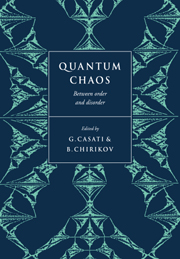Book contents
- Frontmatter
- Contents
- Preface
- Acknowledgments
- Introduction
- Part One Classical chaos and quantum localization
- Part Two Atoms in strong fields
- Localization of classically chaotic diffusion for hydrogen atoms in microwave fields
- Inhibition of quantum transport due to “scars” of unstable periodic orbits
- Rubidium Rydberg atoms in strong fields
- Diamagnetic Rydberg atom: confrontation of calculated and observed spectra
- Semiclassical approximation for the quantum states of a hydrogen atom in a magnetic field near the ionization limit
- The semiclassical helium atom
- Stretched helium: a model for quantum chaos in two-electron atoms
- Part Three Semiclassical approximations
- Part Four Level statistics and random matrix theory
- Index
Inhibition of quantum transport due to “scars” of unstable periodic orbits
Published online by Cambridge University Press: 07 May 2010
- Frontmatter
- Contents
- Preface
- Acknowledgments
- Introduction
- Part One Classical chaos and quantum localization
- Part Two Atoms in strong fields
- Localization of classically chaotic diffusion for hydrogen atoms in microwave fields
- Inhibition of quantum transport due to “scars” of unstable periodic orbits
- Rubidium Rydberg atoms in strong fields
- Diamagnetic Rydberg atom: confrontation of calculated and observed spectra
- Semiclassical approximation for the quantum states of a hydrogen atom in a magnetic field near the ionization limit
- The semiclassical helium atom
- Stretched helium: a model for quantum chaos in two-electron atoms
- Part Three Semiclassical approximations
- Part Four Level statistics and random matrix theory
- Index
Summary
A new quantum mechanism for the suppression of chaotic ionization of highly excited hydrogen atoms explains the appearance of anomalously stable states in the microwave ionization experiments of Koch et al. A novel phase-space representation of the perturbed wave functions reveals that the inhibition of quantum transport is due to the selective excitation of wave functions that are highly localized near unstable periodic orbits in the chaotic classical phase space. These “scarred” wave functions provide a new basis for the quantum description of a variety of classically chaotic systems.
Advances in the study of the chaotic behavior of strongly coupled and strongly perturbed nonlinear oscillators has lead many researchers to the question of how quantum mechanics modifies the chaotic classical dynamics in corresponding quantum systems like atoms or molecules in strong fields. Until Heller's detailed studies of the stadium billiard, highly excited states of chaotic systems were expected to resemble random functions in configuration space. However, Heller found that typical eigenfunctions were often strongly peaked along the paths of unstable classical periodic orbits (PO). In the past year these so-called “scars” of the PO have also been identified in several other systems that are classically chaotic, where the peaking of the quantum probability near PO was found to be even more pronounced in the phase-space (PS) representation of the wave functions. These quantum PS distributions also revealed that the stable and unstable manifolds associated with the PO also play an important role in determining the regular structure of the eigenfunctions.
- Type
- Chapter
- Information
- Quantum ChaosBetween Order and Disorder, pp. 241 - 246Publisher: Cambridge University PressPrint publication year: 1995

